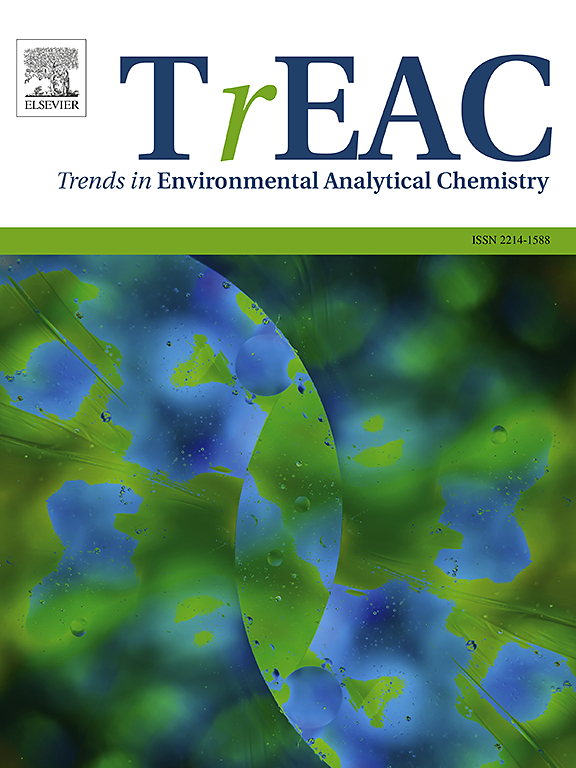从设计到检测:mof功能纳米材料杂交体用于超灵敏电化学监测水生环境中的药物污染物
IF 13.4
2区 化学
Q1 CHEMISTRY, ANALYTICAL
引用次数: 0
摘要
不适当的药物废物处理、无效的废水处理和生产径流导致了水生栖息地中持久的药物残留。这些污染物具有生物蓄积性,促进抗菌素耐药性,并对环境和人类健康构成重大威胁。本研究对混合电化学传感器进行了集中评价,该传感器将金属有机框架(MOFs)与功能纳米材料结合起来,用于非常敏感的水中药物检测。本文重点介绍了分子设计mof,合成后改变和导电纳米材料的结合方面的最新进展(2022-2025),这些进展解决了水解不稳定性和导电性不足的持续挑战。我们批判性地研究了制造方法,包括纳米材料支架上的原位金属有机框架生长,聚合物辅助组装和小型化电极设计,这些设计提供了增强的电子传递,分析物预浓缩和现场部署能力。案例研究展示了在纳摩尔到飞摩尔浓度的水中检测抗生素、镇痛药和激素,强调了在复杂基质中的可靠性。我们描述了现有的挑战——传感器污垢、可重用性和商业可扩展性,并提出了解决方案,包括弹性防污涂层、多路复用传感器阵列和无线物联网系统。这项重点研究旨在指导未来发展可扩展、可现场部署的MOF/纳米材料电化学传感器,以保护水质。本文章由计算机程序翻译,如有差异,请以英文原文为准。
From design to detection: MOF-functional nanomaterial hybrids for ultrasensitive electrochemical monitoring pharmaceutical contaminants in the aquatic environment
Improper disposal of pharmaceutical waste, ineffective wastewater treatment, and manufacturing runoff have resulted in enduring drug residues in aquatic habitats. These pollutants bioaccumulate, foster antimicrobial resistance, and present significant threats to both environmental and human health. This study offers a concentrated evaluation of hybrid electrochemical sensors that combine metal-organic frameworks (MOFs) with functional nanomaterials for the very sensitive detection of drugs in water. This paper highlights recent advancements (2022–2025) in molecularly designed MOFs, post-synthetic alterations, and the incorporation of conductive nanomaterials, which tackle persistent challenges of hydrolytic instability and inadequate conductivity. We critically examine manufacturing methodologies, including in situ metal-organic framework growth on nanomaterial scaffolds, polymer-assisted assembly, and downsized electrode designs, which provide enhanced electron transport, analyte pre-concentration, and field deployability. Case studies demonstrate the detection of antibiotics, analgesics, and hormones in water at nanomolar to femtomolar concentrations, emphasizing reliability in intricate matrices. We delineate existing challenges-sensor fouling, reusability, and commercial scalability-and present solutions including resilient antifouling coatings, multiplexed sensor arrays, and wireless IoT-enabled systems. This focused study seeks to direct future efforts towards the development of scalable, field-deployable MOF/nanomaterial electrochemical sensors for the protection of water quality.
求助全文
通过发布文献求助,成功后即可免费获取论文全文。
去求助
来源期刊

Trends in Environmental Analytical Chemistry
Chemistry-Analytical Chemistry
CiteScore
21.20
自引率
2.70%
发文量
34
审稿时长
44 days
期刊介绍:
Trends in Environmental Analytical Chemistry is an authoritative journal that focuses on the dynamic field of environmental analytical chemistry. It aims to deliver concise yet insightful overviews of the latest advancements in this field. By acquiring high-quality chemical data and effectively interpreting it, we can deepen our understanding of the environment. TrEAC is committed to keeping up with the fast-paced nature of environmental analytical chemistry by providing timely coverage of innovative analytical methods used in studying environmentally relevant substances and addressing related issues.
 求助内容:
求助内容: 应助结果提醒方式:
应助结果提醒方式:


